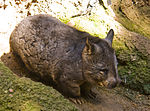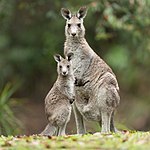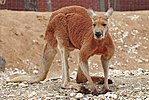
Marsupials are a diverse group of mammals belonging to the infraclass Marsupialia. They are natively found in Australasia, Wallacea, and the Americas. One of the defining features of marsupials is their unique reproductive strategy, where the young are born in a relatively undeveloped state and then nurtured within a pouch on their mother's abdomen.
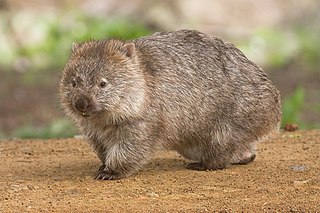
Wombats are short-legged, muscular quadrupedal marsupials of the family Vombatidae that are native to Australia. Living species are about 1 m (40 in) in length with small, stubby tails and weigh between 20 and 35 kg. They are adaptable and habitat tolerant, and are found in forested, mountainous, and heathland areas of southern and eastern Australia, including Tasmania, as well as an isolated patch of about 300 ha in Epping Forest National Park in central Queensland.

Diprotodontia is the largest extant order of marsupials, with about 155 species, including the kangaroos, wallabies, possums, koala, wombats, and many others. Extinct diprotodonts include the hippopotamus-sized Diprotodon, and Thylacoleo, the so-called "marsupial lion".
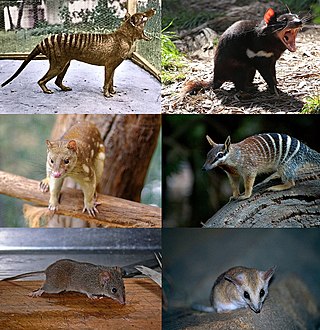
Dasyuromorphia is an order comprising most of the Australian carnivorous marsupials, including quolls, dunnarts, the numbat, the Tasmanian devil, and the extinct thylacine. In Australia, the exceptions include the omnivorous bandicoots and the marsupial moles. Numerous South American species of marsupials are also carnivorous, as were some extinct members of the order Diprotodontia, including extinct kangaroos and thylacoleonids, and some members of the partially extinct clade Metatheria and all members of the extinct superorder Sparassodonta.
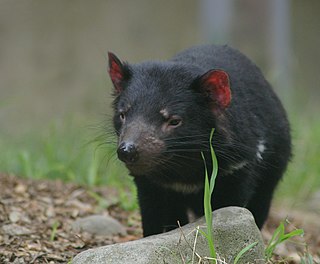
The Dasyuridae are a family of marsupials native to Australia and New Guinea, including 71 extant species divided into 17 genera. Many are small and mouse-like or shrew-like, giving some of them the name marsupial mice or marsupial shrews, but the group also includes the cat-sized quolls, as well as the Tasmanian devil. They are found in a wide range of habitats, including grassland, underground, forests, and mountains, and some species are arboreal or semiaquatic. The Dasyuridae are often called the 'marsupial carnivores', as most members of the family are insectivores.

The Vombatiformes are one of the three suborders of the large marsupial order Diprotodontia. Seven of the nine known families within this suborder are extinct; only the families Phascolarctidae, with the koala, and Vombatidae, with three extant species of wombat, survive.
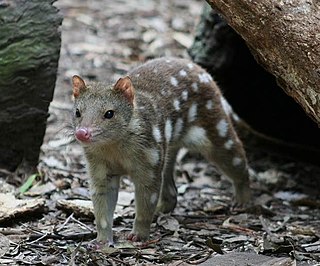
The tiger quoll, also known as the spotted-tailed quoll, spotted quoll, spotted-tailed dasyure, or tiger cat, is a carnivorous marsupial of the quoll genus Dasyurus native to Australia. With males and females weighing around 3.5 and 1.8 kg, respectively, it is the world's second-largest extant carnivorous marsupial, behind the Tasmanian devil. Two subspecies are recognised; the nominate is found in wet forests of southeastern Australia and Tasmania, and a northern subspecies, D. m. gracilis, is found in a small area of northern Queensland and is endangered.

Phascolarctos is a genus of marsupials with one extant species, the koala Phascolarctos cinereus, an iconic animal of Australia. Several extinct species of the genus are known from fossil material, these were also large tree dwellers that browsed on Eucalyptus leaves.

The southern hairy-nosed wombat is one of three extant species of wombats. It is found in scattered areas of semiarid scrub and mallee from the eastern Nullarbor Plain to the New South Wales border area. It is the smallest of all three wombat species. The young often do not survive dry seasons. It is the state animal of South Australia.

The northern hairy-nosed wombat or yaminon is one of three extant species of Australian marsupials known as wombats. It is one of the rarest land mammals in the world and is critically endangered. Its historical range previously extended across New South Wales, Victoria, and Queensland, and as recently as 100 years ago it was considered as having become extinct, but in the 1930s a population of about 30 individuals was discovered located in one place, a 3 km2 (1.2 sq mi) range within the 32 km2 (12 sq mi) Epping Forest National Park in Queensland. With the species threatened by wild dogs, the Queensland Government built a 20-kilometre (12 mi)-long predator-proof fence around all wombat habitat at Epping Forest National Park in 2002. Insurance populations have since been translocated to two other locations to ensure the species survives threats such as fire, flood, or disease.

The common wombat, also known as the bare-nosed wombat, is a marsupial, one of three extant species of wombats and the only one in the genus Vombatus. It has three subspecies: Vombatus ursinus hirsutus, found on the Australian mainland; Vombatus ursinus tasmaniensis, found in Tasmania; and Vombatus ursinus ursinus, found on Flinders Island and Maria Island in the Bass Strait.
The mammals of Australia have a rich fossil history, as well as a variety of extant mammalian species, dominated by the marsupials, but also including monotremes and placentals. The marsupials evolved to fill specific ecological niches, and in many cases they are physically similar to the placental mammals in Eurasia and North America that occupy similar niches, a phenomenon known as convergent evolution. For example, the top mammalian predators in Australia, the Tasmanian tiger and the marsupial lion, bore a striking resemblance to large canids such as the gray wolf and large cats respectively; gliding possums and flying squirrels have similar adaptations enabling their arboreal lifestyle; and the numbat and anteaters are both digging insectivores. Most of Australia's mammals are herbivores or omnivores.
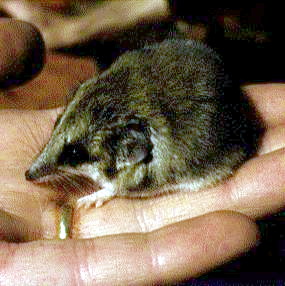
The lesser hairy-footed dunnart is a small carnivorous Australian marsupial of the family Dasyuridae. It is a widespread and fairly common species, being found in many desert areas of Western Australia, Northern Territory and Queensland. Its foraging strategies have been studied by Haythornthwaite and Dickman.

Lasiorhinus is the genus containing the two extant hairy-nosed wombats, which are found in Australia. The southern hairy-nosed wombat is found in some of the semiarid to arid regions belt from New South Wales southwest to the South Australia-Western Australia border. The IUCN categorises it as Near Threatened. Conversely, the northern hairy-nosed wombat is categorised as Critically Endangered and only survives in a 3-square-kilometre (1.2 sq mi) range within the Epping Forest National Park in Queensland, but formerly also existed in Victoria and New South Wales.
Caversham Wildlife Park is a wildlife park currently located in Whiteman Park in Western Australia. It is home to several Australian animals including kangaroos, koalas, possums, wallabies, wombats and Tasmanian devils.
Brookfield Conservation Park is a conservation park located in South Australia, about 130 km northeast of Adelaide.




